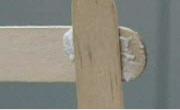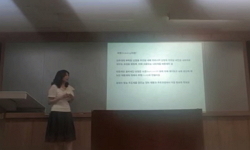본 연구의 목적은 브라켓 접착 시 산부식과 전처리 과정을 결합하여 잡착 단계를 단순화시킨 self-etching primer (SEP)를 사용하는 경우 접착제 종류와 타액의 존재 유무에 따른 전단결합강도의 ...
http://chineseinput.net/에서 pinyin(병음)방식으로 중국어를 변환할 수 있습니다.
변환된 중국어를 복사하여 사용하시면 됩니다.
- 中文 을 입력하시려면 zhongwen을 입력하시고 space를누르시면됩니다.
- 北京 을 입력하시려면 beijing을 입력하시고 space를 누르시면 됩니다.



Self-etching primer를 사용하여 교정용 브라켓 접착 시 접착제와 타액오염에 따른 전단결합강도 변화 = Change in shear bond strength of orthodontic brackets using self-etching primer according to adhesive types and saliva contamination
한글로보기https://www.riss.kr/link?id=A342875
- 저자
- 발행기관
- 학술지명
- 권호사항
-
발행연도
2005
-
작성언어
Korean
- 주제어
-
KDC
515.000
-
등재정보
KCI등재,SCOPUS,SCIE
-
자료형태
학술저널
- 발행기관 URL
-
수록면
433-442(10쪽)
-
KCI 피인용횟수
0
- 제공처
-
0
상세조회 -
0
다운로드
부가정보
국문 초록 (Abstract)
본 연구의 목적은 브라켓 접착 시 산부식과 전처리 과정을 결합하여 잡착 단계를 단순화시킨 self-etching primer (SEP)를 사용하는 경우 접착제 종류와 타액의 존재 유무에 따른 전단결합강도의 차이에 관하여 비교 연구 하는 것이다. 소의 하악 영구 전치를 포매하여 만든 시편을 접착제의 종류에 따라 레진 접착제와 레진 강화형 글래스 아이오노머 접착제를 이용한 군으로 나누었고, 각각 37% 인산으로 산부식 후 기존의 본딩용 프라이머를 사용하여 접착한 군과, SEP를 사용하여 접착한 군으로 분류하고, 타액 오염 유무에 따라 다시 각 군을 분류하여 전단결합강도를 측정하였다. 그 결과 레진 접착제로 브라켓을 부착한 경우 SEP를 사용하여 접착한 군의 전단결합강도는 인산 처리군에 비해 낮은데 비해, 레진 강화형 글래스 아이오노머를 사용한 경우, 전처리법에 따른 전단결합강도는 통계적으로 유의한 차가 없었으며, 접착제의 종류에 관계없이 타액 오염이 존재 시에는 SEP를 사용한 군이 인산 처리군에 비해 높은 전단결합강도를 보였다. 이상의 결과에서 SEP를 사용 시 레진 접착제와 레진 강화형 글래스 아이오노머 접착제 모두 임상적으로 사용 가능한 전단결합강도를 보였으며, 특히 타액에 오염된 치면에서도 SEP를 사용하여 브라켓을 접착하는 것은 적절한 결합강도를 얻을 수 있으므로 임상적으로 유용할 것으로 생각된다.
다국어 초록 (Multilingual Abstract)
The purpose of this study was to evaluate and compare the shear bond strength of orthodontic brachets depending on the variety of adhesives and whether saliva exists. by using self-etching primer (SEP). Groups were divided according to the type of adh...
The purpose of this study was to evaluate and compare the shear bond strength of orthodontic brachets depending on the variety of adhesives and whether saliva exists. by using self-etching primer (SEP). Groups were divided according to the type of adhesive into resin adhesive (Transbond XT) and resin-medified glass ionomer cement (Fuji Ortho LC). One group of resin adhesive used XT primer after etching with 37% phosphoric acid, and the other group used self-etching primer. One group of resin-modified glass ionomer cement only used etching for bonding, and the other group used SEP. Each of the group were also classified by whether saliva was contaminated or not. and then the shear bond strength was measured. The results showed that when using resing adhesive. the shear bond strength of SEP was lower than the XT primer. In the resin-medified glass ionomer cement groups, the shear bond strength which depends on the priming method, did not have a meaningful difference statistically. When saliva was contaminated. the group which used SEP, regardless of the adhesive variety, had a greater shear bond strength than the normal priming group. From these results, SEP showed a shear bond strength that is possible to be used clinically, regardless of the adhesive variety. It can especially be clinically useful to use SEP to bond brackets even on tooth surfaces contaminated with saliva, because it offers the appropriate bonding strength as well as shorter treatment time and easy application.
참고문헌 (Reference)
1 "치과 재료학" 군자 출판사 244-7, 2001
2 "브라켓 간접부착술식시 레진 베이스의 표면 처리가 전단 결합강도에 미치는 영향" 28 : 1-15, 1998
3 "간접부착술식시 치면과 레진 베이스의 간격 및 접착제에 따른 결합강도" 31 : 459-65, 2001
4 "traditional bonding systems in orthodontics an in vitro study" 5 : 166-9, 2002
5 "Use of a self-etching primer in combination with a resin-modified glass ionomer:Effect of water and saliva contamination on shear bond strength" 124 : 420-6, 2003
6 "The use of bovine enamel in bonding studies" 113 : 514-9, 1998
7 "The properties of a glass ionomer cement" 135 : 322-6, 1973
8 "The effect of saliva on shear bond strengths of hydrophilic bonding system" 119 : 54-8, 2001
9 "Shear bond strength of stainless steel orthodontic brackets with a moisture-insensitive primer" 119 : 251-5, 2001
10 "Self-etching primer를 이용하여 접착된 교정용 브라켓의 전단결합강도" 33 : 51-61, 2003
1 "치과 재료학" 군자 출판사 244-7, 2001
2 "브라켓 간접부착술식시 레진 베이스의 표면 처리가 전단 결합강도에 미치는 영향" 28 : 1-15, 1998
3 "간접부착술식시 치면과 레진 베이스의 간격 및 접착제에 따른 결합강도" 31 : 459-65, 2001
4 "traditional bonding systems in orthodontics an in vitro study" 5 : 166-9, 2002
5 "Use of a self-etching primer in combination with a resin-modified glass ionomer:Effect of water and saliva contamination on shear bond strength" 124 : 420-6, 2003
6 "The use of bovine enamel in bonding studies" 113 : 514-9, 1998
7 "The properties of a glass ionomer cement" 135 : 322-6, 1973
8 "The effect of saliva on shear bond strengths of hydrophilic bonding system" 119 : 54-8, 2001
9 "Shear bond strength of stainless steel orthodontic brackets with a moisture-insensitive primer" 119 : 251-5, 2001
10 "Self-etching primer를 이용하여 접착된 교정용 브라켓의 전단결합강도" 33 : 51-61, 2003
11 "Self-etching primer/adhesive를 사용한 교정용 브라켓 접착시 오염이 전단결합강도에 미치는 영향" 34 : 439-47, 2004
12 "Mechanical and bond strength properties of light-cured and chemically cured glass ionomer cements" 105 : 135-41, 1994
13 "Influence of self-etching primer on the resin adhesion to enamel and dentin" 14 : 205-10, 2001
14 "Influence of self-etching primer drying time on enamel bond strength of resin composites" 27 : 203-7, 1999
15 "In vitro shear bond strength of adhesive to normal and fluoridated enamel under various contaminated condition" 30 : 570-5, 1999
16 "In vitro bond strength of two adhesives to enamel and dentin under normal and contaminated conditions" 9 : 295-9, 1993
17 "Glass ionomers for direct bonding:an in vitro assessment" 17 : 223-8, 1990
18 "Epoxy adhesives for orthodontic attachments:progressive report" 51 : 901-12, 1965
19 "Effects of saliva and water contamination on the enamel shear bond strength of a light glass ionomer cement" 113 : 402-7, 1998
20 "Effect of water,saliva and blood contamination on bonding of metal brackets with a 4-META/MMA/TBB resin to etched enamel" 12 : 299-304, 1999
21 "Effect of using self-etching primer for bonding orthodontic brackets" 72 : 558-64, 2002
22 "Effect of the self-etching dentin primers on the bonding efficacy of a dentin adhesive" 8 : 86-92, 1989
23 "Effect of a self-etch primer/adhesive on the shear bond strength of orthodontic brackets" 119 : 621-4, 2001
24 "Effect of a new bonding agent on bond strength to saliva-contaminated enamel" 28 : 93-4, 1994
25 "Direct bonding of orthodontic brackets" 69 : 318-27, 1976
26 "Contemporary orthodontics" Mosby 397-402, 2000
27 "Comparison of the shear bond strength of 2 self-etching primer/adhesive systems" 125 : 348-50, 2004
28 "Comparison of orthodontic bracket bond strength;human vs bovine enamel" 55 : 153-367, 1976
29 "Clinical evaluation of bond failure rates with a new self-etching primer" 36 : 687-90, 2002
30 "Bovine teeth as possible substitutes in the adhesion test" 62 : 1076-81, 1983
31 "Bonding of stainless steel brackets to enamel with a new self-etching primer" 122 : 274-6, 2002
32 "Bond strengths and SEM evaluation of Clearfil Liner Bond 2" 8 : 289-93, 1995
33 "Bond strength of three orthodontic adhesives" 79 : 653-60, 1981
34 "An investigation into the fluoride release of a variety of orthodontic bonding agent" 22 : 29-33, 1995
35 "An in vitro study of the bond strength of glass ionomer cement in the direct bonding of orthodontic brackets" 15 : 247-53, 1988
36 "An ex vivo assessment of a resin-modified glass ionomer cement in relation to bonding technique" 28 : 207-10, 2001
37 "A study of bond strength between light-and self-cured orthodontic resin" 101 : 350-4, 1992
38 "A simple method of increasing the adhesion of acrylic filling materials to enamel surface" 34 : 849-53, 1955
39 "A review of direct orthodontic bonding" 2 : 171-8, 1975
40 "A posttreatment evaluation of direct bonding in orthodontics" 71 : 173-89, 1977
41 "A mathematical model for post- irradiation hardening of photoactived composite resins" 1 : 191-4, 1985
42 "A critique of bond strength testing in orthodontics" 21 : 33-43, 1994
43 "A comparison of shear bond strength and debonding characteristics of conventional,moisture -insensitive,and self-etching primers in vitro" 74 : 264-8, 2004
동일학술지(권/호) 다른 논문
-
3차원 CT 영상을 이용한 정상교합자의 안면 연조직 계측 분석
- 대한치과교정학회 발행
- 유형석
- 2005
- KCI등재,SCOPUS,SCIE
-
- 대한치과교정학회 발행
- 남동석
- 2005
- KCI등재,SCOPUS,SCIE
-
광중합형 레진으로 아말감 면에 브라켓 접착 시 전단결합 강도
- 대한치과교정학회 발행
- 임용규
- 2005
- KCI등재,SCOPUS,SCIE
-
- 대한치과교정학회 발행
- 이성근
- 2005
- KCI등재,SCOPUS,SCIE
분석정보
인용정보 인용지수 설명보기
학술지 이력
| 연월일 | 이력구분 | 이력상세 | 등재구분 |
|---|---|---|---|
| 2023 | 평가예정 | 해외DB학술지평가 신청대상 (해외등재 학술지 평가) | |
| 2020-01-01 | 평가 | 등재학술지 유지 (해외등재 학술지 평가) |  |
| 2010-01-01 | 평가 | 등재학술지 유지 (등재유지) |  |
| 2008-01-01 | 평가 | 등재학술지 유지 (등재유지) |  |
| 2005-01-01 | 평가 | 등재학술지 선정 (등재후보2차) |  |
| 2004-01-01 | 평가 | 등재후보 1차 PASS (등재후보1차) |  |
| 2003-01-01 | 평가 | 등재후보학술지 유지 (등재후보1차) |  |
| 2002-01-01 | 평가 | 등재후보학술지 유지 (등재후보1차) |  |
| 2000-07-01 | 평가 | 등재후보학술지 선정 (신규평가) |  |
학술지 인용정보
| 기준연도 | WOS-KCI 통합IF(2년) | KCIF(2년) | KCIF(3년) |
|---|---|---|---|
| 2016 | 1.13 | 0.47 | 0.83 |
| KCIF(4년) | KCIF(5년) | 중심성지수(3년) | 즉시성지수 |
| 0.67 | 0.55 | 0.311 | 0.24 |




 RISS
RISS




